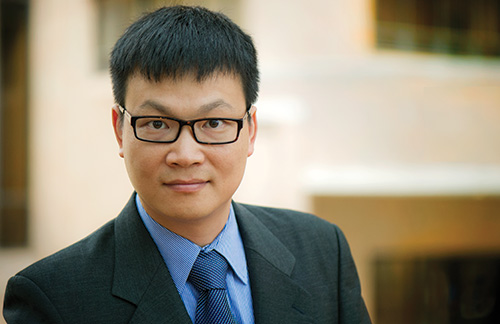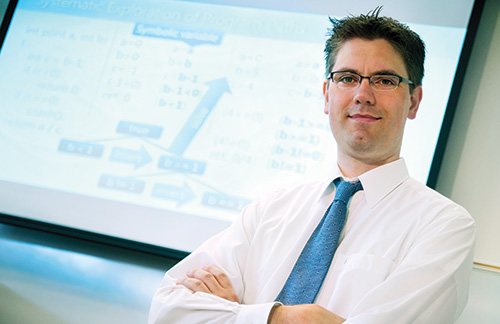For weeks, thieves lurked inside the computers of the Bangladesh Central Bank, hunting for passwords. Finally, armed with the correct credentials, they snatched $81 million from the bank’s account with the Federal Reserve Bank of New York, funneling the funds to shadowy branches in the Philippines. Investigators have yet to solve the dramatic cyber heist, believed to be the largest in history.
The Bangladesh bank theft and others that have followed exposed troubling gaps in the world’s cybersecurity, leaving our public infrastructure vulnerable to attack.
Cybersecurity is one of the most pressing security and economic challenges for the United States and beyond, authorities say. In 2016, President Barack Obama implemented the Cybersecurity National Action Plan, which took near-term actions and put into place a long-term strategy to enhance cybersecurity awareness and protections, defend privacy, maintain public safety and economic and national security, and empower Americans to take better control of their digital security.
Globally, the cost of data breaches is expected to reach an estimated $2.1 trillion by 2019, a four-fold increase from 2015, according to one market forecast agency.
To help combat such attacks, researchers at The University of Texas at Arlington are developing measures to strengthen cybernetworks, detect dangerous viruses before they wreak havoc, and protect software critical to wide-ranging research. In a world increasingly dependent on modern technology, the stakes are high.
Confronting Insider Threats
The image of bank robbers brandishing guns and a note demanding money has long been emblazoned on our collective imagination.
These days, however, authorities are scrambling to build safeguards to protect against a relatively new, emerging threat—insider attacks.

Jingguo Wang uses criminology theories to investigate how insiders can attack important cybernetworks
Jingguo Wang is pioneering research to fight insider threats to banking systems by pinpointing vulnerable spots in networks and developing strategies to mitigate them. Dr. Wang, whose work is funded by the National Science Foundation’s Secure and Trustworthy Cyberspace initiative, is collaborating with a professor at The University of Texas at San Antonio on the project, which is among the first of its kind.
“Insiders can impose very serious damage,” says Wang, an associate professor of information systems and operations management. “Whether their behavior is due to malice or naiveté, the insider threat looms large over the banking industry.”
Investigators now suspect the brazen Bangladesh heist was in part an inside job, and similar cases abound. For example, it’s believed that hackers who targeted Sony Pictures Entertainment in 2014 and Target in 2013 might have been aided, at least in part, by employee wrongdoing.
“Software is invading more and more aspects of our lives, from our phones to our cars, which use computers more than ever. Ensuring our software is safe is about ensuring our own safety and personal privacy.”
Wang is using criminology theories to study how insiders behave on a network and what makes an application high-risk or susceptible to insider threats. (A large-scale financial institution has provided Wang’s team with anonymous records of every interaction on their computer network by thousands of internal users.) He has completed the first part of the research, which involved assessing risk levels and identifying vulnerable spots in systems. Now, his team is studying whether certain circumstances—like working from home, accessing the network after business hours, or working in large versus small departments—increase the likelihood that employees will try to access unauthorized internal systems and data.
“Because employees possess special privileges and have the skills, knowledge, resources, and access, they are able to circumvent traditional security measures,” Wang says. “Security like firewalls and antivirus software are ineffective in detecting and preventing insider threats. They are forcing us to change the way we think about security.”
Eventually, the research could help banks, credit unions, credit card companies, and other financial institutions develop software to reduce this risk, such as access-control tools.
“Our work will provide a deeper understanding of insider threat behavior in the context of financial institutions,” Wang says. “Everyone knows this is a considerable threat, but we do not know how to manage the associated risk.”
“An Arms Race”
The invitation appears innocuous, masquerading as a Facebook request or email from an acquaintance, with instructions to click a link.
Once downloaded, the file dumps malware—short for malicious software—onto your computer with the goal of damaging or disabling the system. In some cases, hackers can then access everything stored in your web browser or hard drive, including emails, bank passwords, and social media logins.

Christoph Csallner is investigating malicious software, which can disable and damage important systems
To help prevent such attacks, computer science and engineering Associate Professor Christoph Csallner and doctoral student Shabnam Aboughadareh have developed a new way to analyze suspicious programs and sophisticated malware.
“Malware and malware analysis are engaged in an arms race,” Dr. Csallner says. “While analysis tries to understand the latest malware, malware is working to evade the latest analysis techniques.”
Malware detection is critical, as the number of system attacks is rapidly growing. More than 390,000 new strains are introduced every day, according to the AV-TEST Institute, an international service provider of IT security and anti-virus research.
“Security like firewalls and antivirus software are ineffective in detecting and preventing insider threats. They are forcing us to change the way we think about security.”
In 2016, several hospitals, schools, and police departments were victims of ransomware, a kind of malware that encrypts or locks valuable digital data and demands a ransom to release it. Hackers in the Bangladesh bank heist even used malware to disable a printer to prevent officials from reviewing a log of the fraudulent transfer requests.
Traditional techniques cannot effectively analyze mixed-mode malware, which contains interdependent components and is more sophisticated than single-domain malware. So Csallner and Aboughadareh developed an approach that combines whole-system analysis with virtual machine introspection—essentially, a host program allows a single computer to run multiple virtual machines.
Called SEMU, or Secure EMUlator, the new software can be used on Microsoft Windows and other operating systems.
“In experiments, our approach analyzed very sophisticated malware that would otherwise evade current analysis approaches,” says Csallner, whose research is funded by the National Science Foundation. “This type of malware is very powerful and can be very dangerous.
“Software is invading more and more aspects of our lives, from our phones to our cars, which use computers more than ever,” he continues. “Ensuring our software is safe is about ensuring our own safety and personal privacy.”
Becoming Bug-Free
Not all threats to our cybernetworks stem from malice. “Big data”—the vast volumes of electronic information generated by satellites, sensors, medical devices, web queries, and other modern technology—has the potential to spur advances in science, engineering, and health care, while furthering our understanding of human behavior. But it requires complex algorithms to unearth patterns, trends, correlations, and associations. Jeff Lei is working to ensure that the software used to analyze the data is free of bugs, which are essentially flaws or faults capable of producing incorrect results.
“Big data is driving advances in many sectors, so it is crucial that these algorithms be implemented correctly in software and that our analysis of data be accurate,” says Dr. Lei, a computer science and engineering professor.
Using combinatorial testing techniques, he is developing tools that engineers can use to detect faults while building the software. His method first identifies the major factors that could impact the behavior of the software being tested. It then uses a systematic approach to test only a small subset of interactions between the factors, which helps developers find a significant percentage of bugs that could exist in the software.
Eventually, Lei’s tools will be fully automated, which will reduce the risk for human error by the software developers using the tools. His project is funded by the National Institute of Standards and Technology, a division of the U.S. Department of Commerce.
Combinatorial testing can detect hard-to-find software bugs more efficiently than manual test methods, saving developers time and money. But it has never been applied to big data software, which poses challenges due to its size and algorithm-intensive nature. Lei’s project is among the first of its kind to do so.
“Our goal is to help software developers build more reliable big data software faster, so they can be confident in their computations,” Lei says. “Our analysis of big data cannot afford mistakes.”
















